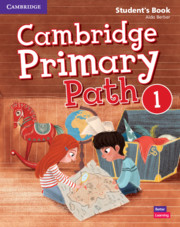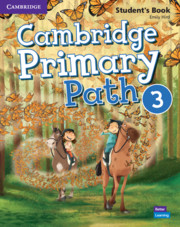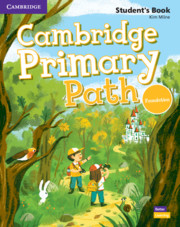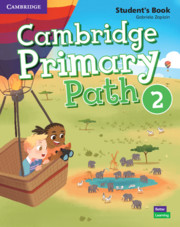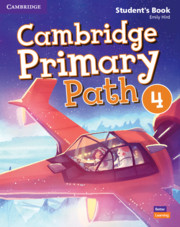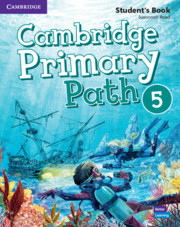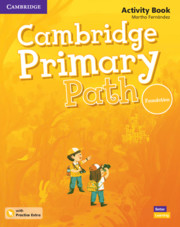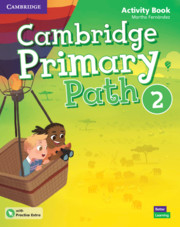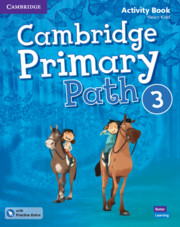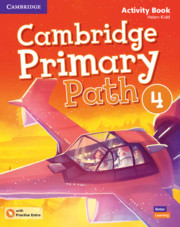Cambridge Primary Path
Key features
Students progress from learning to read, to reading to learn, by developing skills and strategies that help their comprehension of English.
Exposure to natural language allows students to learn and develop through original literature, non-fiction texts, and reading activities.
Empower children to reach their full potential with a unique combination of three learning pillars – literacy, oracy and creativity.
What makes Cambridge Primary Path special?
Each unit poses a Big Question. Students develop the confidence to become critical thinkers in their second language as they investigate, analyse and reason while connecting with the topics on a deeper level in English.
Aside from oracy the course offers many other opportunities to develop communication skills: discussions around Big Questions to encourage critical thinking; activities to build fluency; and missions to practice functional language and high-frequency vocabulary.

A literacy-based approach means that students learn to read and write through exposure to a rich variety of texts, and then use those skills to learn about the world - from learning to read to reading to learn.
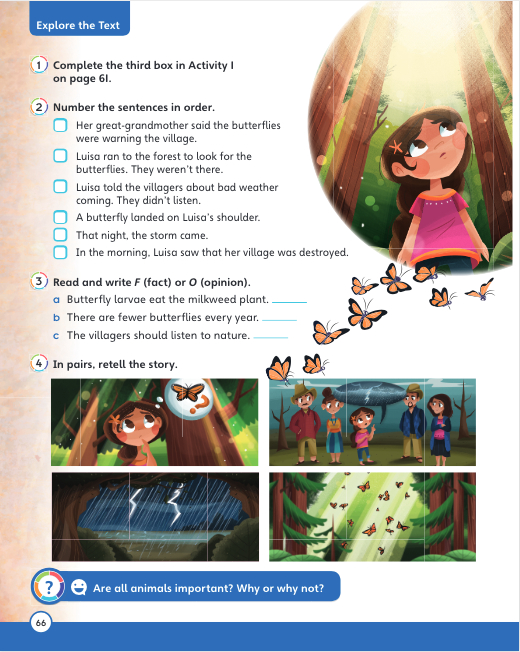
Using 7 creativity principles the course offers a topic-linked Creative Journal and Build Creativity activities in which students practice problem solving and self-expression through puzzles, games, and other imaginative activities which require children to demonstrate cognitive flexibility, analytical skills, imagination and curiosity.

How to find out more
Popular Resources
Popular Resources
Request free sample
Get an e-sample that will allow you to view a product preview on your desktop.
Free sampleSample content
Join the conversation
Research and methodology
With its unique combination of three learning pillars – literacy, oracy and creativity – Cambridge Primary Path empowers children to reach their full potential. Children become confident and effective communicators with inquiring minds, who can think laterally and make the most of life’s opportunities in the 21st century.
Literacy
The ability to read, write and communicate “connects people and empowers them to achieve things they never thought possible” (International Literacy Association website).
A literacy-based approach connects students with rich language through a variety of texts to help them to read and write. There is evidence that the following combination of literacy approaches has a positive effect on children’s learning:
Storytelling
Dialogic reading
Phonics and activities that develop knowledge of letters and sounds (Education Endowment Foundation website)
All these components form part of Cambridge Primary Path.
Find out more from the whitepaper on "Extensive reading for primary in ELT" by Peter Watkins.
With a strong focus on literacy and extended teaching hours, Cambridge Primary Reading Anthologies is designed to be used alongside Cambridge Primary Path. Units, themes and target vocabulary follow the same structure, creating the complete language and literacy program. The anthologies can also be used as standalone reading practice.
This six-level extensive reading series will delight young learners and develop a love of reading naturally with its carefully selected fiction and nonfiction texts from award-winning authors and illustrators.
Like Cambridge Primary Path, Cambridge Primary Reading Anthologies integrates a literacy-based reading approach that enables students to:
Explore diverse genres including detective and sci-fi stories, humorous poetry, music blogs, science articles and personality quizzes
Engage with a Big Question in every unit to develop critical thinking skills
Expand key functional and academic vocabulary
Learn Common Core reading strategies to build confidence and accelerate progress
Find out more on Cambridge Primary Reading Anthologies here
Oracy
'Oracy is to speaking what numeracy is to maths or literacy to reading and writing' (English Speaking Union website). It is our ability to speak confidently in a variety of situations, from presentations in front of an audience to participating in group discussions and collaborative activities.
Our oracy framework developed with experts at Faculty of Education, Cambridge University systematically develops the different oracy skills. The oracy activities are clearly labeled and include the following skills:
Physical: effective and appropriate expression and delivery (e.g. fluency, pace, voice projection, gestures and posture)
Linguistic: clear organisation of thoughts
Cognitive: clarifying, asking questions
Social and emotional: active listening and responding appropriately (e.g. turn-taking)
Find out more about oracy from the whitepaper "The development of oracy skills in school-aged learners"
by Professor Neil Mercer and Dr Lyn Dawes.
Creativity
Creativity is the ability to generate original and innovative ideas, alternatives or possibilities. It is key to effective problem-solving and life long learning.
The creative activities that promote engagement, concentration, ability to view topics from various angles and resilience develop students’ lateral thinking, improve problem-solving skills and make learning enjoyable (Sternberg, 1996).
Cambridge Primary Path implements creativity principles to ensure children develop and practice these qualities throughout the course. The 7 principles are:
Flow: concentrating so hard on a task that you become totally immersed and lose track of time
Focus: doing just one thing, without distraction
Try, Try, and Try Again: finding new ways to solve problems and realizing that your mistakes and failures are part of the creative process
A Different Point of View: making the effort to see things in a different way or try new approaches
Take a Break: leaving a task, especially when stuck, and coming back later to consider new possibilities
Why, Why, Oh Why? (or Questions, Questions, Questions): being inquisitive opens your mind up to new possibilities, while justifying answers supports the retention of knowledge and encourages you to consider multiple perspectives
Start All Over Again: starting all over again when you get stuck often leads you to understand why something didn’t work
What is Oracy?
Oracy involves systematically focusing on and practicing the skills that make you a better communicator. So, much more than just speaking and listening, this involves learning to listen actively, to present ideas clearly, to work collaboratively and express confidence through your body posture.
'Oracy is to speaking what numeracy is to maths or literacy to reading and writing' (ESU website). Just as literacy skills are learnt, oracy skills also need to be taught and practiced.
They include the following skills:
Physical: effective and appropriate expression and delivery (eg fluency, pace, voice projection, gestures and posture)
Linguistic: clear organisation of thoughts and use of register
Cognitive: reasoning, clarifying, summarising, evaluating
Social and emotional: active listening and responding appropriately (e.g. turn-taking, involving others)
Practically, this involves: using talk to be effective in collaborative activities and discussions; guiding or teaching another person; listening sensitively to another's experience; and mastering the skills required to be effective in interviewing, public speaking and debate.
Why is oracy important?
Oracy development has a positive impact on a child's educational achievement across the curriculum, their social confidence and future success in the workplace.
How have we implemented oracy in the course?
Research shows that the development of oracy skills is most effective when embedded in the teaching and learning of the subject. Therefore, in Cambridge Primary Path an oracy framework developed in collaboration with leading oracy experts at the Faculty of Education, University of Cambridge, is used to provide systematic development of oracy skills through the course, alongside language and literacy.
Each unit includes an oracy page, on which the oracy characters—Oracy Morris and the children—present the target oracy skill via an animated oracy video.
Students practice the oracy skill through a task and observe each other
Cue Cards provide the functional language students need to complete the task
Students reflect on their skills in Check Your Oracy!
Oracy Reminders are strategically interspersed throughout the units to remind students to use the oracy skills they have learned
An Oracy Extension activity on either the Listening or Big Challenge page reinforces the target oracy skill in every unit
Other speaking content
The following non-oracy areas also feed into Cambridge Primary Path’s communication/speaking program, the combination of which make it unique:
Informal, spontaneous opportunities to chat on non-academic, child-oriented topics and build fluency—Time to Talk! boxes
Discussions and development of critical thinking skills in the Big Question links
Practice of functional language and high-frequency vocabulary in the Speaking Missions
Why creativity?
Why is creativity important?
Creativity is the ability to generate original and innovative ideas, alternatives or possibilities. It is key for success in a knowledge and innovation economy. (OECD, 2017)
Cambridge Primary Path features a topic-linked Creative Journal (which comes with the Student's Book) and Build Creativity activities in the Teacher's Edition in which students practice problem solving and self-expression through puzzles, games, and other imaginative activities which require children to demonstrate cognitive flexibility, analytical skills, imagination and curiosity.
7 Creativity principles
The creative content is founded on 7 creativity principles which reflect why creative activities benefit learners:
Children relax and learn in a personalised context
Children enter into a playful mindset that acknowledges multiple solutions to a problem
Children have fun
Children practice critical thinking, problem-solving and innovation
Children express themselves naturally, in a low-pressure, non-academic context
Children learn to take risks and learn from their mistakes
Children are motivated to keep learning throughout their lives.
Student Components
Student's Book
Cambridge Primary Path Student's Book is an essential component of the series. Together with the Creative Journal and Activity Book it deliveres the program's objectives:
Develop students' rich, natural vocabulary as well as emotional competencies with fiction and nonfiction texts
Get students to investigate Big Questions from a variety of angles
Develop oracy skills such as body awareness and listening skills for confident communication
Get students to act out stories, think creatively, collaborate on projects and enjoy learning with every step!
In the Student's Book you will find:
Nine units plus a Welcome unit
A Big Question and inquiry-based learning integrated in every unit - fascinating documentary-style videos introduce the Big Questions
Beautiful literature - one in every unit - with activities that practice literacy, comprehension and emotional competencies
Nonfiction texts - one in every unit - inspired by children's magazines introduce reading strategies and provide meaningful content on a wide range of topics
Oracy lessons, introduced in animated videos featuring Oracy Morris and friends
Grammar, phonics and values pages
Creative Journal (with Student's Book)
The topic-linked creative journal (9 units of 4 pages) encourages students to practice problem solving and self-expression through puzzles, games, and other imaginative activities which require children to demonstrate cognitive flexibility, analytical skills, imagination and curiosity.
Activity Book with Practice Extra
The Activity Book offers extensive opportunities to review, practice and extend the content from the Student's book.
Practice Extra
The digital environment in Cambridge One has been developed specifically for Primary-age learners, with appealing design, easy access, intuitive navigation and motivating and engaging content.
Practice Extra is packed with consolidation and extension activities for vocabulary, grammar and skills, along with games and rewards, all found on an easy-to-navigate and engaging learning path. It celebrates success, maps progress and motivates young learners. It is intended to be used as homework or in the lab at school and adapts to any device. The activities are unique to Practice Extra and are in addition to those found in the Student and Activity Books.
With Practice Extra teachers can set up classes, access each learner’s data and progress, and set assignments.
Grammar and Writing Workbook
The optional Grammar and Writing Workbook provides an extra two pages of grammar practice for each grammar point and an extra three pages of writing practice per unit.
Teacher Components
Teacher's Edition
Full-color Teacher's Book with reproductions of the Student’s Book. It offers:
Step-by-step guidance for each lesson, including a summary of lesson learning outcomes and materials needed
Big Question links to thoroughly embed the Big Question throughout the unit
Think! sections to encourage critical thinking
Build Creativity! activities
Dialogic reading questions to support every text
Differentiated instructions to cater to students of varied abilities in the same class
Recommendations for extension and reinforcement of grammar, vocabulary, writing and oracy skills
Fun Corner activities to lighten the academic program with games and play
Audio scripts and answer keys
Flashcards
Printed flashcards are available for Levels 1–4. They illustrate the key vocabulary from the unit opener video and nonfiction texts. They correspond to Key Words 1 and Key Words 2. Printable flashcards are available digitally for Levels 5 and 6.
Digital Tools
The full digital pack for teachers is in Cambridge One
Cambridge One provides easy, multi-device access to all the teaching and learning materials for the course, all in one place. Age-appropriate experiences for different age groups ensure that learners feel engaged and challenged at the right level. Actionable data insights within Cambridge One enable you to track progress, measure success and drive results.
Please contact your nearest Cambridge sales rep for your activation code.
The Digital Pack of each level of Cambridge Primary Path contains the following tools:
Presentation Plus
This features the Student’s book and Activity Book with interactive activities and answers, plus integrated audio and video materials; digital flashcards, oracy cue cards; and Teacher's notes.
Teacher’s Resource Bank
Study Guides for each unit make it possible for parents to work with their children while they study for unit exams and assessments:
Speaking evaluation grids
Class audio
Printable flashcards
Oracy cue cards
Grammar and Writing Workbook answer keys
Unit-themed activities designed for parents and children to do together at home
Teacher Training Online
Cambridge Primary Path comes with an online self-study course that introduces teachers to the course methodology and components as well as offering practical ideas for how to make the most of the programme in class. It is designed to help teachers teach Cambridge Primary Path with confidence. The course includes:
- Online self-study program that introduces course methodology through a mix of video, animations and reading texts.
- Introduction to the course components.
- Comprehension and self-reflection activities.
Explore the path
Have a look at the Big Questions, beautiful literature, nonfiction texts, oracy lessons and more.
Download the samples below.







